St. Helen is said to have found the true cross, the one on which Jesus Christ was crucified. Today many rosaries begin with a simple cross or with a crucifix, a cross that has an image of Christ. The crucifix or cross on a rosary usually gives clues as to the rosary’s dedication.
Hebrews 6:19 states, “We have this hope as an anchor for the soul, firm and secure”. The Mariner’s Crucifix is based on a ship’s anchor. Prior to 300 A.D., Christians often used an anchor as a symbol of their faith.
The Mariner’s Crucifix is sometimes referred to as St. Clement’s Cross. Legends state that in 100 A.D., Emperor Trajan exiled Pope Clement to the Crimea. Instead of living quietly, however, the pope spent his time converting residents of the area to Catholicism. When Emperor Trajan learned of these actions, he ordered that the pope should be drowned at sea. His body was to be tied to an anchor so that he would never be found. Soldiers carried out this order but there was a surprise. The sea parted, Pope Clement’s body was found, and he was honored by those he brought to Catholicism.
The Budded Crucifix has tips that resemble flower buds. This crucifix has also been called the Trinity Crucifix because the three parts of the bud remind Christians of the Holy Trinity of the Father, Son, and Holy Ghost. It has been given a third title, The Apostle’s Crucifix, because there are a total of 12 buds, one for each apostle.
Celtic Crucifix
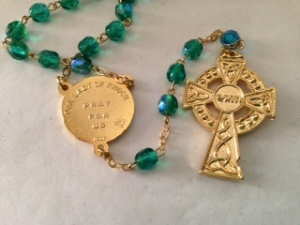
The back of the Knock center medal says, “Our Lady of Knock Pray for Us”. The back of the Celtic Crucifix says, “Erin”.
It is said that the Celtic Cross was born when St. Patrick drew a cross through a Celtic circle as he was speaking about God, the Father. Rosaries may contain a Celtic Crucifix ( Celtic Cross with a figure of Christ) as in the green rosary above or a simple Celtic Cross as in the crystal rosary below.
Associated with Ireland, the Celtic Cross is often found on rosaries made with traditional Irish materials such as Connemara Marble or Waterford Crystal.
Stations of the Cross Crucifix

The Stations of the Cross Crucifix is a pictorial crucifix. Four stations are shown on the front and the remaining ten are displayed on the reverse. Rosaries with this crucifix are often made with beads in Lenten or Easter colors.
Center Medals and Crucifixes
Rosary collectors examine center medals and crucifixes to determine age and authenticity. The inscription on the rosary above shows that it is a souvenir of the Cathedral of St. Anne de Beaupre’ in Canada and its center medal also has an image of St. Anne. Because the center medal and crucifix have a connection and are made of the same material, it seems likely that all pieces of this rosary are original.
A rosary’s crucifix reveals clues that let collectors know its age, place of origin, and purpose. A crucifix is a beautiful work of art as well as an historical artifact.
To learn more about rosaries, crosses, crucifixes, and center medals, read The Rosary Collector’s Guide by Gloria Brady Hoffner and Helen Hoffner. This 152 page hardcover reference book has 240 color photographs of unique religious items. It helps collectors identify old and new rosaries.
Helen Hoffner and Gloria Brady Hoffner, authors of The Rosary Collector’s Guide, are often able to bring their rosary collection to show to church groups, school groups, and community organizations. If you would like to arrange a presentation or ask a question, contact them at rosarycollector@aol.com



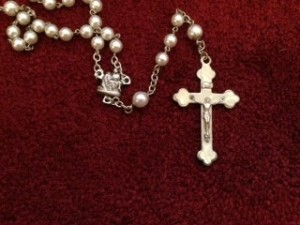

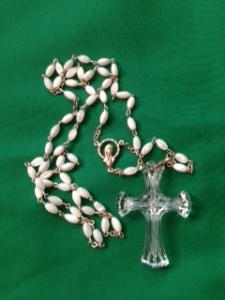



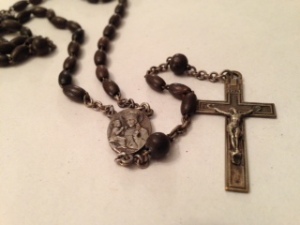
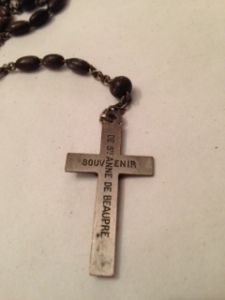

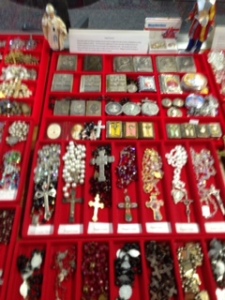

Interesting fact about St. Helen.
Rosary Collector wrote: > a:hover { color: red; } a { text-decoration: none; color: #0088cc; } a.primaryactionlink:link, a.primaryactionlink:visited { background-color: #2585B2; color: #fff; } a.primaryactionlink:hover, a.primaryactionlink:active { background-color: #11729E !important; color: #fff !important; } /* @media only screen and (max-device-width: 480px) { .post { min-width: 700px !important; } } */ WordPress.com rosarycollector posted: ” St. Helen is said to have found the true cross, the one on which Jesus Christ was crucified. Today many rosaries begin with a simple cross or with a crucifix, a cross that has an image of Christ. The crucifix or cross on a rosary usually gives clues”
LikeLike